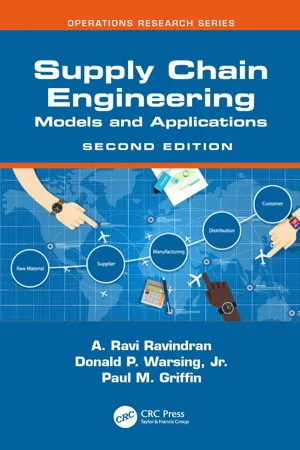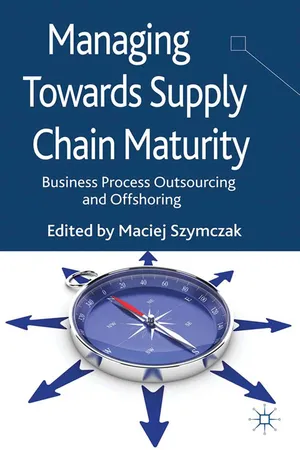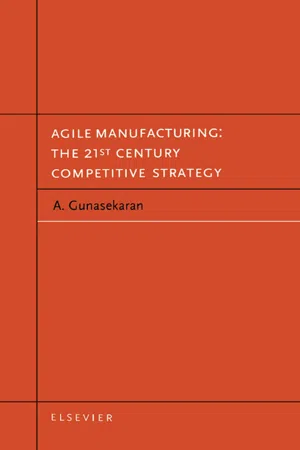Technology & Engineering
Supply Chain Engineering
Supply chain engineering involves the design, optimization, and management of the flow of goods, services, and information from the point of origin to the point of consumption. It focuses on improving efficiency, reducing costs, and enhancing overall performance within the supply chain. This field integrates engineering principles with logistics, operations management, and technology to create more effective and sustainable supply chain systems.
Written by Perlego with AI-assistance
Related key terms
8 Key excerpts on "Supply Chain Engineering"
- eBook - ePub
Supply Chain Engineering
Models and Applications
- A. Ravi Ravindran, Donald P. Warsing, Jr., Paul M. Griffin(Authors)
- 2023(Publication Date)
- CRC Press(Publisher)
Given this broad background on the subject of the book, let us now spend some time carefully setting the stage for the various topics that will be covered in the chapters that follow. In this chapter, we begin with the meaning of Supply Chain Engineering and describe, at a high level, the types of decisions made in managing a supply chain. We introduce a variety of supply chain performance measures and show how they relate to a company’s financial measures. We then discuss the importance of Supply Chain Engineering and the distinguishing characteristics of those firms recognized as leaders in supply chain management. We end with a chapter-by-chapter overview of the textbook.1.1 Understanding Supply Chains
Before we formally define Supply Chain Engineering, we begin with the definition of what a supply chain is.A supply chain consists of the following:- A series of stages (e.g., suppliers, manufacturers, distributors, retailers, and customers) that are physically distinct and geographically separated at which inventory is either stored or converted in form and/or in value.
- A coordinated set of activities concerned with the procurement of raw materials, production of intermediate and finished products, and the distribution of these products to customers within and external to the chain.
Thus, a supply chain includes all the partners involved in fulfilling customer demands and all the activities performed in fulfilling those demands. Figure 1.1 illustrates a typical supply chain.FIGURE 1.1 Typical supply chain network.It is important to recognize that the different stages of the supply chain (suppliers, plants, distribution centers (DCs), and retailers) may be located in different countries for a multinational company with a global supply chain network. It is also possible that a firm may employ fewer supply chain stages than those represented in Figure 1.1 , or perhaps more. Indeed, some business researchers (e.g., Fine, 2000 ) argue that the supply chains in various industries follow historical cycles that move from periods of significant vertical integration to periods of significantly less integration, where firms in the supply chain rely more on partnerships than on owning substantial portions of the value chain within a single firm. In vertical integration periods, the supply chain may employ only a few stages from raw material extraction to final production, owned primarily or exclusively by a single firm. A good example of this would be the early days of Ford Motor Company in the 1920s. In the less integrated periods, it is the horizontal, across-firm relationships that are prominent. A good example would be in the 1990s and early 2000s, when Dell led the global market for personal computers with a highly decentralized supply chain in which they served only as the final assembler and direct distributor. In this latter case, Dell not only relied heavily on its suppliers to independently manage the production and supply of components but also simply bypassed independent distributors and retailers and dealt with the final consumers directly, without the “middlemen.” Of course, in the early 2000s, Dell added the retail “middlemen” back to its supply chain and morphed into a more traditional, build-to-stock computer manufacturer as PCs increasingly became commoditized products. Apple, however, is a good example of how Fine’s (2000 - eBook - ePub
An Introduction to Operations Management
The Joy of Operations
- Ajay Das(Author)
- 2015(Publication Date)
- Routledge(Publisher)
https://mckinsey.secure.force.com/EP/job_details?jid=a0xA0000002JdM51AKBottom_of_Form .In summary, supply chains have to be designed, and how that is done will affect everything from product pricing to customer service and profit margins.Key Points- Supply chain design selects and integrates suppliers of raw material, components, assembly, logistics, distribution, and warehousing capabilities into a coherent configuration that delivers value to the consumer.
- Supply chain management coordinates and motivates the entities in a supply chain to work together for common goals.
- A value chain describes the activities that capture the most value in a supply chain, where such value resides, and to whom it accrues.
- Supply chain design is dynamic, anticipating and changing shape with changes in the demand and supply markets.
10.3 How to Design a Supply Chain
There are several frameworks in supply chain design that we can use: Hau Lee of Stanford University identified the three key objectives of supply chain design as agility, adaptability, and alignment; Charles Fine of MIT1 believes that the structure of a product and its rate of change of technology determine the structure of its supply chain. Marshall Fisher (1997) of Wharton prescribed efficient supply chains for commodity products and responsive chains for innovative products, while Salvador et al. (2004) matched different levels of product customization to different configurations of supply chain design. Others have combined supply chain designs into lean-agile structures that serve both cost and responsiveness goals at different stages of the supply chain.2 We integrate the various prescriptions into a guideline for the supply chain designer, using a product of everyday use, the telephone, as an example.10.3.1 A Template for Supply Chain Design
There are three distinct elements in supply chain design: supply network, assembly, and distribution. Designing each begins with understanding the nature of the market and designing a product that fits market demands. - eBook - ePub
Managing Towards Supply Chain Maturity
Business Process Outsourcing and Offshoring
- M. Szymczak, M. Szymczak(Authors)
- 2015(Publication Date)
- Palgrave Macmillan(Publisher)
The supply chain means the integration of key business processes carried out by all consecutive suppliers of products and providers of services and information that add value for customers and stakeholders 5 (Lambert, Cooper and Pagh 1998, p. 1). The supply chain may be understood as an extended enterprise in which the importance of the boundaries to-date of companies carrying out its processes is decreasing. The flow of products, information and funds in an extended enterprise is strictly coordinated (Langley et al. 2009, p. 20). Examples of supply chains are presented in Figure 1.1. Today we often speak about the demand for flexible (Gow, Oliver and Gow 2002), agile (Christopher 2000), proactive (Smeltzer and Siferd 1998), responsive (Gunasekaran, Lai and Cheng 2008) and resilient (Christopher and Peck 2004) supply chains; in other words, without going into an explanation of the differences between them, supply chains that can dynamically adapt to changes in their environments and to market trends. Supply chain flexibility is required in five dimensions (Vickery, Calantone and Droge 1999): Figure 1.1 Examples of supply chains Source : Own study. – product flexibility (customisation), – volume flexibility, – launch flexibility, – access flexibility, – responsiveness to target markets. The success of the supply chain depends on the integration of the management systems used by its links, collaboration in the supply chain, the establishment of long-term relationships, the coordination of flows, the compatibility of information systems, and mutual commitment, responsibility and trust (Moberg, Speh and Freese 2003). Procurement, manufacturing and distribution in a supply chain may be carried out in various countries. Some of these processes may be carried out in the home country, others abroad. This applies also to measures related to waste recycling – Table 1.1. These processes are handled by units of the company or by third parties located in the respective countries - Stefano Ronchi(Author)
- 2018(Publication Date)
- Routledge(Publisher)
Table 1.1 shows a set of the main definitions of Supply Chain Management provided in the last two decades.Table 1.1 Main definitions of Supply Chain ManagementYear Author Definition 1982 Oliver and Webber Management of the internal supply chain that integrates business functions involved in the flow of materials and information from inbound to outbound ends of the business. 1985 Jones and Riley An integrative approach to dealing with the planning and control of the materials flow from suppliers to end-users. 1991 Ellram A network of firms interacting to deliver product or service to the end customer, linking flows from raw material supply to final delivery. 1992 Christopher Network of organizations that are involved, through upstream and downstream linkages, in the different processes and activities that produce value in the form of products and services in the hands of the ultimate consumer.1992 Lee and Billington Networks of manufacturing and distribution sites that procure raw materials, transform them into intermediate and finished products, and distribute the finished products to customers. 1994 Berry et al. Supply chain management aims at building trust, exchanging information on market needs, developing new products, and reducing the supplier base to a particular OEM (original equipment manufacturer) so as to release management resources for developing meaningful, long term relationship.- eBook - ePub
- Ron Basu, J. Nevan Wright(Authors)
- 2006(Publication Date)
- Routledge(Publisher)
Figure 5.1.Traditionally the information flow was the domain of the commercial division while the conversion process of materials flow was a manufacturing or technical division responsibility. With an integrated supply chain approach the responsibility for all elements of supply is now with operations management or supply chain management. In many businesses, the integrated approach is being extended to include all suppliers through the manufacturing processes to each level of customer (including wholesalers and retailers where appropriate through to the end user or consumer). This is known as the extended supply chain.Figure 5.1 Supply chain managementThe supply chain in servicesAs a result of the heightened expectations of customers, operations managers in service sectors also have been forced to focus their attention on managing the value adding system underpinned by the principles of supply chain management. Thus we have seen the emergence and growth of supply chain management as a dominant force for operational success.But what exactly is supply chain management in a service context? Simchi-Levi et al. (2003) define it as follows:Supply chain management is a set of approaches utilized to efficiently integrate suppliers, manufacturers, warehouses and stores, so that merchandise is produced and distributed at the right quantities, to the right locations, and at the right time, in order to minimize system-wide costs while satisfying service level requirements.What does this definition suggest? It suggests that supply chain management must consider every organization and facility involved in making the product and the costs involved in doing so. It also implies that the objective is to be cost-effective across the whole supply chain, which requires a system-wide approach to optimization. The supply chain of a service organization also contains suppliers, products or services, customers and their demand for products and service level agreements. The service inventory can be in the form of information databases and stationery items. - eBook - ePub
Supply Chain Strategies
Demand Driven and Customer Focused
- Tony Hines(Author)
- 2024(Publication Date)
- Routledge(Publisher)
4 The emergence of supply chain management and supply chain strategy as a critical success factor for organizationsDOI: 10.4324/9781003393290-4Introduction
The purpose of this chapter is to discuss the emergence of supply chain management, the underlying concepts and the development of supply chain strategies as an important influence upon successful organization strategies and operations. The chapter begins with a discussion of historical developments generally and in organizational management that have created the necessary conditions for the emergence of supply chains as an important focus for managers. It then moves on to address contemporary issues that occupy the mind space of practising managers. Empirical examples demonstrate the importance of the supply chain phenomena in creating successful strategies, structures and relationships that enhance organizational value. Finally, future directions are considered before outlining a new research agenda for this developing and important aspect of business management.Supply chain management was a phrase first coined in the early 1980s to describe the range of activities co-ordinated by an organization to procure and manage supplies (Oliver & Webber, 1982 ). Initially the term referred to an internal focus bounded by a single organization and how they sourced and procured supplies, managed their internal inventory and moved goods on to their customers, (Harland, 1995 ; Macbeth & Ferguson, 1990 ). The original focus was later extended to examine not simply the internal management of the chain. It was recognized that this was inadequate and that the reality in managing supplies meant that supply chains extended beyond the purchasing organization and into their suppliers and their supplier’s supplier (Christopher, 1992 - eBook - ePub
- A. Gunasekaran(Author)
- 2001(Publication Date)
- Elsevier(Publisher)
The rest of the chapter is organised as follows. First, a scalable co-operative supply chain is defined as a special class of a supply chain network that offers flexibility, reusability, and extensibility across problem domains. An information technologies framework is described next. A systems approach applied to managing it describes a supply chain management system. For efficient management of a supply chain, its design must be capable of being configured flexibly. A scheme for supply chain configuration is described to accomplish this. Configuring a supply chain involves creating an information & knowledge base, and utilising it in the decision-making process, which are described next. An example of information technologies implementation for a CSC is described following this. Finally, conclusions on this research and plans to extend it are presented.2. SCALABLE CO-OPERATIVE SUPPLY CHAIN
The concept of supply chain is about managing co-ordinated information and material flows, plant operations, and logistics [1 ]. It provides flexibility and agility in responding to consumer demand shifts with minimum cost overlays in resource utilisation. The fundamental premise of this philosophy is synchronisation among multiple autonomous business units represented in it. That is, improved co-ordination within and between various supply chain members. Co-ordination is achieved within the framework of commitments made by Members to each other. Members negotiate and compromise in a spirit of cooperation, in order to meet these commitments. Hence, the label co-operative supply-chain (CSC). Increased co-ordination can lead to reduction in lead times and costs, alignment of interdependent decision-making processes, and improvement in the overall performance of each Member, as well as the supply chain network (Group) [2 –4 ].The purpose of this type of organization is to transform incomplete information about the market and available resources into coordinated plans for production and replenishment of goods and services in the network formed by cooperating units. One of the major characteristics of this organization type is scalability. Scalability - eBook - ePub
Supplier Relationship Management
Unlocking the Value in Your Supply Base
- Jonathan O'Brien(Author)
- 2022(Publication Date)
- Kogan Page(Publisher)
network and across the literature out there it can be difficult to understand exactly which bit each is focusing on, leaving the reader to fill in the gaps. Hieber (2002) states that:Whilst many proponents of SCM talk at length about the supply side, others suggest the chain or network continues right to the end customer. Melzer-Ridinger (2003) suggests:Supply Chain Management is the integration of the activities associated with the flow and transformation of goods in the respective logistics networks through improved supply chain relationships based on a common collaborative performance measurement framework for attaining close, collaborative and well coordinated network relationships to achieve a sustainable competitive advantage.SCM has the task to design and operate the flow of material into, through and out of the enterprise as well as the relevant administrative information and coordination processes in a way to guarantee an error-free, robust, quick and efficient servicing of the final client.This is also supported by Mentzer et al (2001) who suggest the philosophy of SCM must include the ability to view the entire supply chain and manage the flow of goods from supplier to ultimate customer.There are many views on exactly what SCM does and concerns itself with; to some it is little more than the flow of materials to suit the purposes of the firm whilst to others it is about relations and interactions throughout the system, the flow of information and targeted interventions to increase end customer value. It is easy to get lost in the broad range of definitions out there, all waving the SCM banner so in this chapter I will attempt to summarize the key concepts. In terms of definitions, the one that I favour that seems to be the simplest is that of Christopher (2011), a definition that is quite a few years old now but remains very relevant, who describes SCM as:
Index pages curate the most relevant extracts from our library of academic textbooks. They’ve been created using an in-house natural language model (NLM), each adding context and meaning to key research topics.







